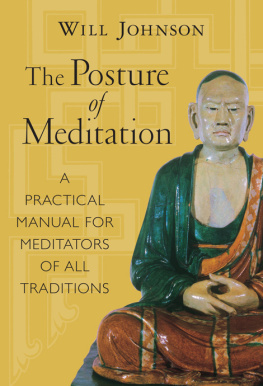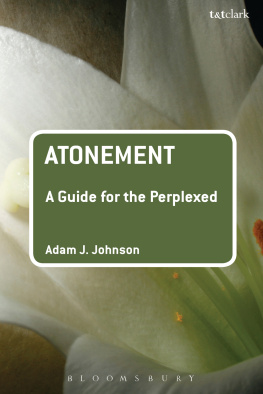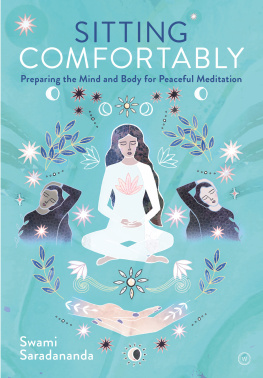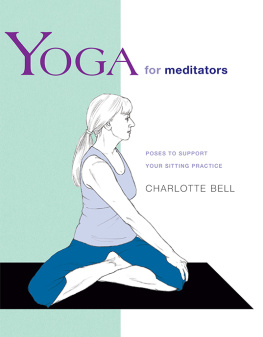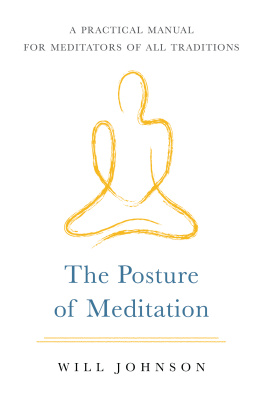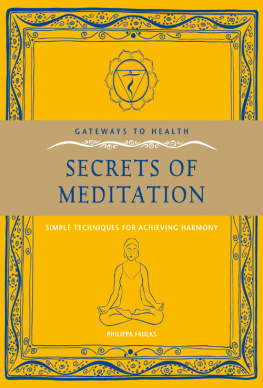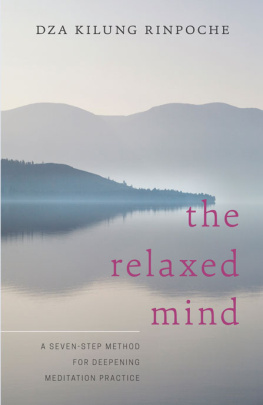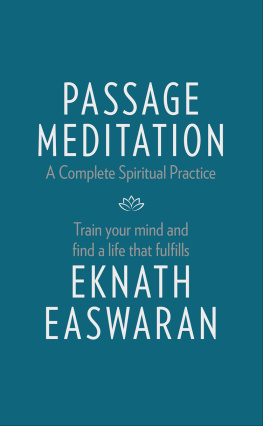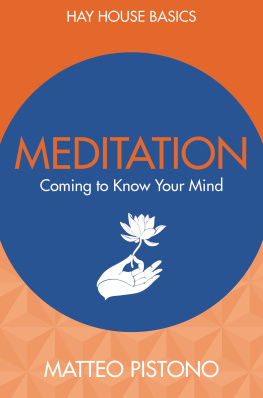ABOUT THE BOOK
When it comes to meditation practices, the body is as important as the minda fact that may come as a surprise to the many people who regard meditation as a strictly mental activity. But, as Will Johnson shows, the physical aspect of the practice is far too often underemphasized. The alert-yet-relaxed sitting posture that is the common denominator of so many meditative techniques is a wonderful aid for clearing the mind and opening the heart, but it also works to activate the natural healing energies of both body and mind. The author offers guidance and exercises for working with the posture of meditation and advice on how to carry its benefits on into all the rest of life.
WILL JOHNSON is a certified bodyworker and director of the Institute for Embodiment Training in his hometown of Cobble Hill, British Columbia.
Sign up to learn more about our books and receive special offers from Shambhala Publications.

Or visit us online to sign up at shambhala.com/eshambhala.

Shambhala Publications, Inc.
Horticultural Hall
300 Massachusetts Avenue
Boston, Massachusetts 02115
www.shambhala.com
1996 by Will Johnson
Cover art: Glazed ceramic figure of Luohan (A.D. 9071125), copyright British Museum.
All rights reserved. No part of this book may be reproduced in any form or by any means, electronic or mechanical, including photocopying, recording, or by any information storage and retrieval system, without permission in writing from the publisher.
Library of Congress Cataloging-in-Publication Data
Johnson, Will, 1946
The posture of meditation: a practical manual for meditators of all traditions/by Will Johnson.
p. cm.
eISBN 978-0-8348-2510-9
ISBN 978-1-57062-232-8
1. Meditation. I. Title.
BL624.2.J65 1996 96-7535
158.12dc20 CIP
This book is dedicated to all those people who have had the good fortune to bring a sitting meditation practice into their lives, in hopes that the information here may further assist and support them in their practice.

Contents

I WOULD LIKE to express my thanks and appreciation to all my teachers of sitting meditation: Koon Kum Heng, Tarthang Tulku, Ruth Denison, Hari Das Baba, Yogi Bhajan, Jack Kornfield, Joseph Goldstein, S. N. Goenka, and Namkhai Norbu. Special thanks and acknowledgment must go to Ida Rolf, who led me to understand that the harmonizing of the energy field of the body with the gravitational field of the earth is a prerequisite for spiritual unfolding, and to Judith Aston, who inspired me to take that harmonization a step further and to explore how an aligned body moves. I would like to thank Emily Hilburn Sell and Dave ONeal of Shambhala Publications for shepherding this book so smoothly through the stages of publication. I would also like to thank Lis Erling Bailly for creating the elegant drawings and symbols.
Many of the structural principles and ideas in this book were first presented in my Balance of Body, Balance of Mind: A Rolfers Vision of Buddhist Practice in the West (Atlanta: Humanics, 1994), and the interested reader who would like to pursue the implications of the posture of meditation further would do well to look there.

ORDINARILY WE think of meditation as an activity involving our minds, but in truth meditation is initiated by assuming a specific gesture with our bodies. This gesture or posture forms the literal base on which the focused inquiry of meditation ultimately rests and depends. If we build a house with a faulty foundation, we create great difficulties for ourselves when we later take up residence. In the same way, if we do not focus our attention initially on establishing a posture that naturally supports and aids the process of meditation, we create many difficulties for ourselves as we attempt to make progress in our meditative quest.
The word posture comes from the Latin positura, which means a position, and ponere, to place. Applied as it customarily is to the structure and appearance of our body, it refers to how we position or place our body in space and to how the different segments of the body relate to one another. In addition, posture or posturing may refer to an attitude or self-image that we self-consciously create, identify with, and project. The determined slouch of an alienated or angry person, the overly developed musculature that attempts to conceal insecurity, the affectation of casual confidence by a lawyer attempting to win over a juryall of these self-images ultimately depend on holding our bodies in different ways to create a desired effect. By holding our bodies, we create different postures that express different attitudes.
Mostly this kind of posturing or posing carries with it a connotation of unnaturalness. We can tense the muscles in our body and hold ourselves in different postures to manufacture a desired persona or self-image. This is precisely what actors do as they attempt to enter into a role, and consequently theater schools spend a great deal of time focusing on the purely physical aspect of the actors craft. However, the natural state of the human being, as with any animal, is to be balanced and relaxed. By consciously manipulating our bodies so that we can create and project a specific self-image, we limit our range of expression, restrict the natural movement of energy within our bodies and minds, and forfeit the natural ease of balance and relaxation that is our true birthright.
The French word poseur describes this condition quite accurately. It refers to someone who is trying to be something other than what he or she naturally is, an imposter. Contrasted with this unnatural way of being in the body, the posture of meditation aligns our bodies and minds in the most comfortable, guileless way with the greater forces of nature that condition us. In this way we accept ourselves as we are in truth and experience no need to be anything other than what we naturally are already. As we learn to let go of some of our unnatural posturings and posings and enter more comfortably into the posture of meditation, we find that what we naturally are is very wonderful indeed. We experience a comfort and relaxation that reveal ever deeper insights into our true nature.
Just as the gradual, but consistent, evolution of the human species toward an ever more upright and vertical posture has been accompanied by a parallel growth and expansion in consciousness, so too do the higher states of consciousness that can be contacted through the process of meditation themselves depend on the continued refinement of verticality and relaxed balance in the body. This preliminary act of coming to balance as the primary condition on which the inquiry of meditation can proceed is often overlooked, however. Meditation, instead, is mostly presented as a variety of different techniques or activities in which we engage our minds and on which we focus our attention. We may, for example, be instructed to sit and silently repeat a word or phrase or to visualize and merge with the image of a deity. We may be told to sit and pay attention to the passage of breath as it moves in and out of the body or to observe the ever-changing contents of our bodies and minds. We may be asked to sit and attempt to come up with an answer to an insoluble riddle or to imagine a cord of expanding white light in our spines. We may be instructed to sit and listen to the inner sounds of the body or to focus on one particular point in the body to the exclusion of all others. We may sit down and contemplate the meaning of a specific passage from a book we value, or we may simply be instructed to sit and do nothing at all.
Next page
